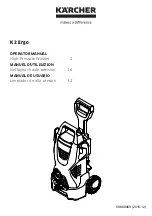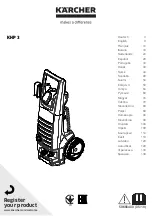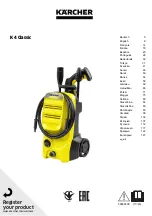
8
♦ If you have any questions on recipes, time charts, or the operation of your pressure cooker, call or write: Test Kitchen, National
Presto Industries, Inc., 3925 North Hastings way, Eau Claire, wisconsin 54703-3703, phone 1-800-368-2194. You may also contact
us at our website www.GoPresto.com. when writing, please include a phone number and a time when you can be reached during
weekdays, if possible. written inquiries will be answered promptly by letter or telephone.
quesTIons & answers
Occasionally the cover is hard to open or close. What causes this? What should I do?
In order for pressure to build inside your pressure cooker, the unit has a special cover which provides an airtight fit. Because of this, you
may find that on occasion the cover may be difficult to open or close. The following suggestions
will help if this happens:
If the cover seems hard to close, press the palm of your hand on the center of the cover while
moving the cover handle to the closed position with your other hand. See page 4, Figure G.
If after browning meat or poultry the cover is difficult to close, it may be due to expansion
of the pressure cooker body from heating. Remove the cover and allow the pressure cooker
body to cool slightly and try again. Do not place the pressure cooker back on the burner until
it is fully closed.
If necessary, to help make the cover easier to open and close, a very light coating of cooking
oil may be applied to the sealing ring and to the underside of the lugs on the pressure cooker
body (Fig. R). Use a pastry brush, a piece of cloth, or your fingertips and be sure to wipe off
any excess oil.
What can be done if the food prepared in the pressure cooker has more liquid than desired?
with the cover removed, simmer to evaporate the excess liquid. Next time you prepare the same recipe, you may want to use less liquid.
How does one prevent overcooking?
Remember to begin timing as soon as the pressure regulator begins to rock gently. It is very important to accurately time the cooking period.
A Presto
®
kitchen timer is very helpful for this purpose. Also be sure to follow the recipe instructions for cooling the pressure cooker.
What if the food is not completely done after the recommended cooking time?
Simply bring the cooker back up to pressure and cook the food a minute or two longer.
Can I use my pressure cooker on all types of ranges?
Your pressure cooker will work on gas, electric coil and ceramic glass (smoothtop) ranges. In addition, stainless steel pressure cookers
will work on induction ranges.
When cooking first begins, is it normal for steam to escape and moisture to form on the cover and between the handles?
It is normal for steam to escape and a slight amount of moisture leakage to form on the cover and between the handles when cooking first
begins. If leakage continues, the cover handle may not be properly aligned with the body handle and, therefore, the cover lock cannot
engage.
My cooker is making a loud, unpleasant sound. The blue cap in the middle of the cover is also lifting up and emitting steam. What
is causing this?
The pressure relief valve is a warning device that is designed to provide both visual (the blue cap lifts and steam comes out the sides) and
audio (a fast, steady release of steam, often times accompanied by a continuous unpleasant sound) signals to indicate that the vent pipe
has been blocked and is no longer regulating pressure. If you see and/or hear either of these signals, immediately turn off the burner. Do
not move the cooker. Instead, allow pressure to drop of its own accord. when there is no pressure in the cooker (see #6, page 5), remove
the pressure regulator from the cover, open the cooker, and clean the vent pipe (see page 6).
NOTE:
Do not operate the cooker again until you have replaced the pressure release valve. The high pressure which triggered the release
may have contaminated the valve with food particles, which could prevent it from acting as a warning and a backup pressure release
valve if the vent pipe is plugged again.
Remember a plugged vent pipe is a result of user error.
•
Never
overfill the cooker.
•
Never
cook the foods listed in #2, page 5 in a pressure cooker.
•
Always
follow the special procedures when cooking rice, grains, and dry beans and peas (see #11, page 6).
Apply Cooking
Oil Here
Fig. R
Apply Cooking
Oil Here









































